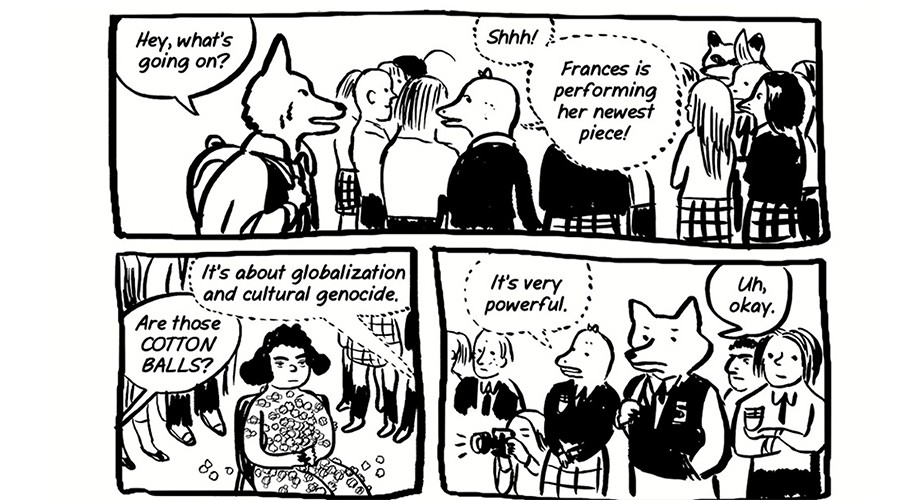
SuperMutant Magic Academy
Publisher: Drawn & Quarterly
Writer & Artist: Jillian Tamaki
Review by Anelise Farris
 SuperMutant Magic Academy by Jillian Tamaki is the 2016 Eisner winner for “Best Publication for Teens.” Although SuperMutant Magic Academy was published in April of 2015, I just got around to picking it up (*sheepish grin*) after the Eisner winners were announced. First, it needs to be stated that SuperMutant Magic Academy was a webcomic that ran from 2010 to 2014. The publication that came out in 2015 was a printed collection of all the webcomic strips as well as a few new strips and a conclusion. I was not familiar with the webcomic prior to picking up the collection, but as a big fan of Skim (2010) and This One Summer (2014), I was familiar with Tamaki’s work.
SuperMutant Magic Academy by Jillian Tamaki is the 2016 Eisner winner for “Best Publication for Teens.” Although SuperMutant Magic Academy was published in April of 2015, I just got around to picking it up (*sheepish grin*) after the Eisner winners were announced. First, it needs to be stated that SuperMutant Magic Academy was a webcomic that ran from 2010 to 2014. The publication that came out in 2015 was a printed collection of all the webcomic strips as well as a few new strips and a conclusion. I was not familiar with the webcomic prior to picking up the collection, but as a big fan of Skim (2010) and This One Summer (2014), I was familiar with Tamaki’s work.
SuperMutant Magic Academy is, like the settings of all wonderful magic-filled school stories, a place of learning, mischief, and adventure for mutants and wizards. There is flying, spells gone awry, cat classmates, etc. BUT that is not what this book is about. Tamaki’s comic focuses on all of the angst and heartache of the “teen” experience—rather than any advantages that might come from being supernatural. The premise is certainly intriguing, and the art is nicely executed: composed primarily of thin lines and black and white pages, with brief bits of color and broader strokes here and there. Despite the seemingly simplistic panels, Tamaki’s work, with its expressionist quality, is evocative and pairs nicely with the text.
However, even with the interesting plot and compelling art, I have mixed feelings about SuperMutant Magic Academy—particularly because of the category it won: “Best Publication For Teens,” which is aimed at 13 to 17 year olds. However, when I went to my local library to check it out, it was not in the children’s/YA graphic novel section. It was in the adult’s graphic novel section. At first I thought it amusing and probably wrong—thinking (with much annoyance) that some suggestive material or “non-normal” characterization caused one to deem it inappropriate for teens.
But, after reading it, I believe the shelving decision was appropriate. SuperMutant Magic Academy didn’t feel like a YA book to me for several reasons:
- A common misconception is that just because a book features kids or teens it is a children’s/YA book. I believe that this is what happened with Tamaki’s work.
- Rarely are YA books as self-aware and overtly critical/sardonic of the current culture as SuperMutant Magic Academy. Frances, the misunderstood artist, was especially confusing to me. I couldn’t tell if I was supposed to laugh/groan/applaud at her continual artistic exploits.
- The plot has no clear trajectory (I realize this is due to it being a serial, but the collection doesn’t make that clear), and the language/tone is inconsistent: it fluctuates from poetic to colloquial to theoretical to mundane.
All of that aside, there are some truly great comic strips within this collection and some fantastic lines: “…I think you’re maybe looking for a narrative that doesn’t necessarily exist?” (168). That one gave me chills. Also, I found myself preferring the darkly humorous strips that were more about pictures than words. It was at these moments, such as when Trixie throws a rock into a lake, and we see it destroying a fish’s home, that Tamaki’s work is truly intriguing—bringing up all these thoughts about cause and effect, good intentions gone awry, human hypocrisy, etc. However, again, this is not typical of YA, especially for younger YA reads (aimed at those between 13 and 15). Ultimately, SuperMutant Magic Academy, with its moments of brilliance and poignant critique, is thought provoking in a way that makes it seem aimed at an older audience.
Verdict:
Borrow it! My perspective may have been affected by 1) not being familiar with the web comic and 2) it’s Eisner award, but unless you are a huge fan of the online serial and want them all in one printed collection, SuperMutant Magic Academy is one to borrow from a friend or your local library. For young readers in particular, I’d suggest viewing the webcomic first; by being aware of what you are getting into—particularly the lack of a clear narrative trajectory—you’ll appreciate it better.



